Teresa
Bevin's Cuba Blog |
|
|
|
|
|
|
|
|
|
|
Week
Two in Camagüey, Cuba
|
Current Week's Blog |
|
Publications
Photos
News
Reviews
Links
Appearances
Home
|
Friday, January
23, 2004 - Estoy cansada. I am tired.
Mentally and emotionally, more than physically. I
am finally back in the United States. There is much to
say-- when my head stops swimming with this montage of
images, sounds and impressions. I was prepared to
see changes in Camagüey, though that would mean I might
lose some physical evidence of my past life. What
I hadn't anticipated was how so much there still
remained the same. It was a pain I could not share with
those who were living it.
More tomorrow.
Thursday, January
22, 2004 - My face is much better today, thank
you. The redness and swelling from the dermatitis
has subsided and I'm not consuming as large a dose of
antihistamine. I'll be departing from Cuba in a
few hours, filled with ideas and memories -- happy to
return home, but sad to be leaving my old homeland,
friends and family. I've learned some lessons over
the past few weeks and want to write more about this
journey after I get back to the states. This little web
site does not have enough space to express what I hold
in my heart.
|
Menu
español
Cuba-Blog
Datos
de Teresa
Publicaciones
Fotos
Noticias
Reseña de
Libros
Enlaces
Colaboraciones
y Charlas
Indice
|
|
|

The road from Camagüey
|
|
Julio
gave me one of his drawings as a gift. I was very
touched. Although he is artistically adept,
creation does not come easily for him. Parting with even
one drawing is like giving me a jewel. Much of
yesterday was spent preparing for my departure,
including registering with the government my intent to
take the drawing out of the country. Apparently
the loss of artistic and historical patrimony in Cuba
rose to scandalous levels after the revolution, and
depleted the country's cultural inventory. Now the
government is recording and tracking the movement of art
(new and old) and historical objects. Not a bad
idea. But the process took 45 minutes of answering
questions, measuring, describing, writing, measuring,
describing and answering questions. The clerk
certainly earned her entire month of 200 pesos with my
little drawing.
I
distributed whatever toiletries and medicine I brought,
and decided to leave my light-weight $8 bargain suitcase
-- it didn't fall apart in transit as I feared it
might. As I packed the small carry-on bag with my
remaining possessions, I couldn't stop thinking about
the bittersweet existence of the population and what
might be seen as Job-like patience with situations that
would push people from most other countries over the
edge. But is it patience or a resignation to a
life of extreme contrasts? Hard to tell. There are many
things that go unsaid here. A country of silent
philosophers. All I know is that tears will flow
before the day is over -- but the music will continue.
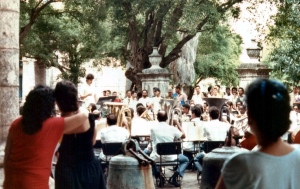
|
|
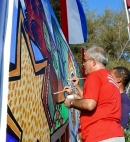
Camagüey artists paint mural
commemorating victims of September 11 attacks in the
U.S. |
|
|
|
Contemporary Art from Cuba: Irony and Survival on the Utopian Island = Arte Contemporaneo De Cuba : Ironia Y Sobrevivencia En LA Isla Utopica

|
|
|
|
Top of
Page |
|
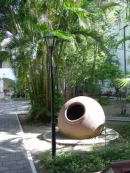
Tinajone in the courtyard
of Iglesia La Merced, Camagüey, Cuba.
January, 2004
|
Wednesday, January 21, 2004 - This is ridiculous. I'm nearing the end of my
visit and I have contact dermatitis! I am
not feeling pretty. Yesterday, just before I went
out to meet with more friends and relatives, I
applied cream to my face
because my skin was dry. I did
not consider that the cream contained vitamin A. I
did not consider the caution on the tube of cream that
stated users should stay out of direct sunlight after
application. Remember, walking is a
way of life in Cuba. So is the sun. Within a few
hours after walking through the streets of Camagüey , my face was
flushed and warm to the touch. I thought it was
the less-than-gourmet (but generously offered and only
available) beer my hosts had served me. It
progressively worsened throughout the afternoon. Today,
a doctor confirmed my ailment to be from the face cream,
not the beer. He said he could see the edges
of the swelling around the sides of my face where I
didn't spread the cream. Something to be thankful
for -- I spread the cream evenly so I'm not
striped. Tomorrow is my last day in
Cuba. I really don't want the people here to
remember me with dermatitis.
Oh, and
again today we have no
electricity. Something happened when they were
fixing something somewhere in preparation for the 490th
Anniversary of the founding of Camagüey, Cuba.
And because there's no electricity, there's no water --
each building has its own electrical pump bringing water
into the building. Even the hotel, the
cyber café and the church are without power. It
is dark and the only lights to be seen are on the
occasional bikes
and scooters and cars on the street -- and in the bank
on the other side of the plaza. The bank still has electricity.
|
|

El Trio, Havana 2003
|
|
|
Listen
to Sabor a Mi
performed by the Havana group El
Trio and reproduced with the permission of the
artists. (High speed internet connection
recommended) |
|
|
|
|
|
|
|
Top of
Page |
|
|
|
|
|
|
Tuesday, January 20, 2004 - The Andalusian poet and playwright Federico Garcia Lorca, after
his visit to Cuba in the thirties,
said: "En Cuba, no os sorprendais de nada."
["In Cuba, do not be surprised/alarmed for any
reason."] This continues to be true.
Here, heart transplants are performed for free, while a broom costs $1 USD. (25 pesos).
The average salary is 200 pesos. One pound of plaintains for cooking (10 plantains) cost 2 pesos, a head of garlic anywhere from 2.50 to 4 pesos.
Remember that the average salary is per month. Cuba used to produce anywhere between 7 and 8 million tons of sugar each harvest. Now it cannot produce 3 million.
The fields between the city of Camagüey
and Santa Lucia beach are invaded by a thorny bush known as
marabu -- Impenetrable, thick, difficult to eradicate. Why?
"Do not be surprised..." Nobody knows.
On the final stretch toward the beach, there is a horrendously huge sign in red print that says
"Traffic signals are deficient." I never saw one single traffic signal the rest of the
way.
People drink more rum than water. Water is scarce, especially in Camagüey, where the aqueduct has always been deficient
-- probably due to the flat land. The rum that people buy in the regular store is not
Havana Club or Cubay. It is turpentine. I have not tasted it and won't.
This is the age of cloning. It is done here with
certain farm animals. Technology is on the leading edge. People understand computers easily, readily. They use homeopathy, aromatherapy, hypnosis, behavior
modification. Everyone has pampered dogs that eat the same food as their owners. Veterinary medicine is limited to cows, pigs, and horses.
The beauty is breathtaking, the love is overwhelming, the music is catchy, youth is gorgeous and aging comes quickly.
|
|
|
|
|
|
|
Monday, January 19, 2004 -
Today four buses pulled up in front of the church La
Merced and on their heels pedaled an army of Bici
Taxis. The buses let loose a babble of
tourists who dispersed on foot and in bici taxis
to take in the sights of Camagüey City. Bici
taxis are 3-wheeled bicycles with a bench attached
to the rear axle. Some have a canopy that covers
just the passengers, other have larger, extended
canopies. Bici taxis are everywhere in
Cuba. When I was in Havana, I was enthralled by
the Coco Taxis -- little yellow fiberglass shells
propelled by a 3-wheeled scooter. They're
cute, comfortable and zippy. They haven't made it
yet to Camagüey.
I
think that if I lived here, I would feel like I'd been
shipwrecked and adrift at sea -- surrounded by water,
but with none to drink. That's how it is for
Cubans -- surrounded by technology and other aspects of
modern society, but with few exceptions, unable to drink
of it. Many people in the city still don't have a
telephone, much less cell phone. The cyber cafés are
closed at least 25% of the time due to technological
failures of some type. Few private
citizens have computers, and those that do can't access
the internet, only e-mail. Fresh food and
quality supplies are available for American dollars. The average Cuban earns 200
pesos each month, which is the equivalent of $8.00
US. I hesitate to consider what a computer
costs.
|
|
Cuban Taxis |
|
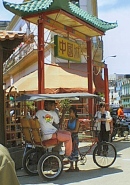
Bici Taxi
|
| |
|
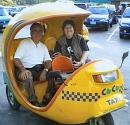
Coco Taxi
|
|
|
|
|
Top of
Page |
|
|
|
|
|
Camagüey
Weather
Links
|
|

My father, Perfecto Rodriguez, one of the owners of Empacadora La Unión, a meat packaging
company
|
|
|
Sunday,
January 18, 2004 - In spite of the thriving art
communities in the city of Camagüey, daily life still
borders on the provincial. There is no comparison to
Havana where, even in the worst of times, something is
always going on. I guess that since there's no sugar
being produced anymore, and the cattle industry has been
greatly decreased -- two products that made Camagüey a
center for trade and commerce -- the city needs to
reinvent itself. Like the rest of Cuba, the city of
Camagüey is looking to attract tourism, but it still has
a way to go.
I am impressed by the amount of people
visiting Iglesia de La Merced. Because the
church is right next door, I can hear every word of the
music and service. Because today is Sunday, the
sounds of the priest, the congregation's prayers and
singing drifted into the apartment throughout the
morning. I could even listen to the sermon while in
the bathroom.
I went to the cemetery today to visit my
family's crypt. In Cuba, as in many European
countries, cemeteries do not contain separate graves for
each individual, but have ground-level crypts for many
generations of one family. There are also
special crypts for workers' organizations, military units,
etc. My grandfather is buried in the crypt with the
postal carriers. When I last visited the cemetery
ten years ago, the graves bore signs of vandalism.
As a
result of severe shortages, metal ornamentation and
fixtures had been stripped from the markers to be used by
the living. There were no fresh flowers to be seen,
only meager and worn plastic imitations. Today I saw
many fresh flowers laid in remembrance throughout the
cemetery, and although the hardware has not been replaced,
many crypts were patched or whitewashed.
|
|
Camagüey
Cemetery |
|

|
|
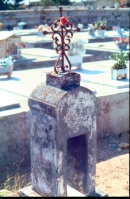
|
|
|
|
|
|
|
|
Saturday,
January 17, 2004 - The beach at Santa Lucia was fantastic.
The weather perfect. I hope you folks in the
states get a
reprieve from the cold. Last night Burlington, VT
was featured on Cuban TV. They said 40
below and a Civil Emergency. Geeze. Here it
couldn't be more ideal.
We met some people from New Zealand who
had fallen in love with Santa Lucia. Most people
do. The water is completely clear.
You could see your toenails against the bottom.
I tried to be moderate and did not get sunburned. We ate
a great lunch of perch, salad, and rice. We swam a lot and
enjoyed the view.
Returning
back to the city of Camagüey, we drove through several little towns.
The "traffic" on the roads consisted of
people who were hitchhiking, and trucks of all sizes, loaded
with passengers on the truck beds. Everywhere there are
horse-drawn carriages with signs
that read "CUBA TAXI."
There aren't as many cows as I
remember. Neither is there any sugar cane.
The fields are dry because this place has
seen no rain in a long long while. On the way to
the beach we stopped at the ruins of an old sugar mill
that used to be operated by slaves. The wheel is
still there, and it says "New York." There was
also the biggest bee hive I've ever seen.
Millions of them. I took pictures of three
little girls who were playing around it! The
hive was near a cafeteria where we stopped for coffee. The attendant was playing
Celia Cruz's last CD. Very odd. People love to
play Celia.
The beach was full of tourists, mostly German and
Canadian, it seems. But
we found a nearly empty spot and rented chairs that cost
a dollar each. Comfy though. After a long
swim, we had lunch and were serenaded by a group of
musicians. No. It wasn't a group, it was a
crowd. Loads of guitars and bongos. But
not pushy people. Just nice guajiros with a
great sense of humor who did not expect five bucks.
They were great.
The way back was adorned by a sunset to die for.
And a traffic jam of cows and horses.
Now we are home. The church is chiming.
I'm dusty and gritty and need a shower. Ah
yes, the water came back yesterday!
|
|
Santa Lucia
Beach
Camagüey, Cuba |
|

|
|
|

|
|
| |
|
|

Traffic jam, Camagüey countryside
|
|
|
View
Last Week's Blog |
|
|
|
|
Top of
Page |
|
|
| Although support to ease
restrictions on travel to Cuba for non-Cuban born Americans
appears to be growing, it is still illegal for most U.S.
citizens to travel to that island. The
U.S. Department of State website
and the
U.S. Treasury website contain regularly updated
guidelines for the public. |
|
NOTE:
The U.S. Interests Section, Havana lists the latest U.S.
Government Statements and News on U.S. Policy toward Cuba.
|